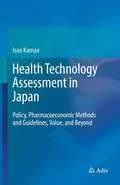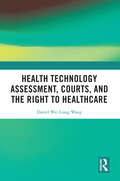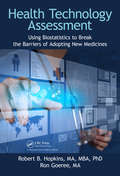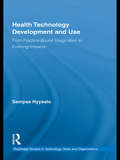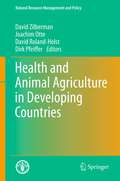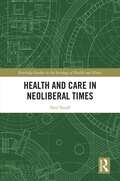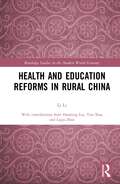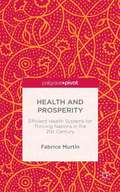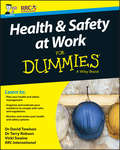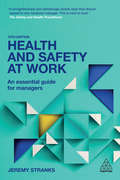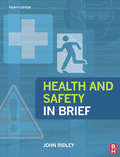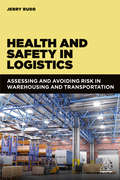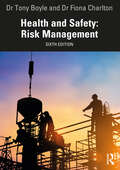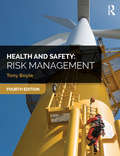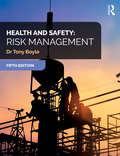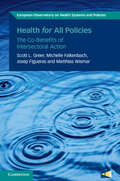- Table View
- List View
Health Systems in the Developing World
by Kevin Schulman Gary Carbell Muhammed PateThis teaching note offers an approach to the evaluation of health care markets globally. The note prepares students with a set of questions about the organization of core elements of the health care system. The organization of these elements can vary across markets, and can vary in terms of the different roles of the public and private sector in financing and delivery of health care services. Overall, the framework provides an opportunity for a structured analysis of any market in health care, and provides students with a comprehensive approach to assessing the current health care market. Students can build from this framework with their own assessments of potential opportunities for business or policy innovation within the market.
Health Tech: Rebooting Society's Software, Hardware and Mindset
by Trond Arne UndheimGlobal healthcare will change drastically in the next decade due to key technologies, social dynamics, and systemic shifts that are already in motion. However, shaping the future requires being aware of the opportunities and able to capitalize on them to one’s family and the community’s benefit. Health tech can be a part of the solution, but tracking the right startups and influencers takes know-how. The grand challenges of our time demand that we coordinate better than ever before. Social movements can both accelerate and slow down change. Health systems across the world need to reboot, with private partnerships and new governance paradigms that have global reach but local legitimacy, but exactly how can this be done considering the collective action problem and complexity involved? Health Tech: Transforming Public Health Innovation at the Edge fulfills the need for actionable insight on what’s truly driving change and how to become a changemaker, not just affected by it. The book introduces anybody who wishes to understand how global healthcare will change in the next decade to key technologies, social dynamics, and systemic shifts that are shaping the future. Healthcare Futurist, investor and entrepreneur, Trond Undheim, describes the complex history of public health, why it’s so complicated and what the major challenges right now. He includes a discussion of COVID, why it happened, the cultural factors that has slowed down traditional public health measures and how innovation can help. He also discusses what is happening in health systems around the world as a result of the pandemic. The book also explores certain health tech measures, tools (basic medical devices gradually being upgraded and digitally enhanced), processes and innovation which are already working well, and others that are in their infancy such as AI, wearables, robotics, sensors, digital therapeutics and others. The author also describes the movers and shakers in the healthcare system of the future from startups to patients and services providers and the health challenges of our time including the pandemic, aging and preventive healthcare and much more. The book concludes with a look at how health tech may provide the biggest opportunity to transform healthcare for decades to come.
Health Technology Assessment in Japan: Policy, Pharmacoeconomic Methods and Guidelines, Value, and Beyond
by Isao KamaeRepresenting the first book on the topic, this work offers the reader an introduction to the Japanese systems for health technology assessment (HTA) officially introduced by the Ministry of Health, Labour and Welfare (MHLW) in 2016. Policy and guidelines are discussed, with the relevant methods and conditions of cost-effectiveness analysis explained alongside. Numerous instructive examples and exercises, ranging from basic to advanced, impart valuable knowledge and insight on the quantitative methods for economic evaluation, which will appeal to both beginners and experts.This guidebook is authored by Japan’s foremost expert in HTA and pharmacoeconomics, with a view to strengthening the reader’s expertise in value-based healthcare and decision-making. The methods presented are essential to informing regulatory, local and patient decisions; as such, the book is equally recommended to industry and government, as well as academia, and anyone with an interest in Japanese HTA.
Health Technology Assessment, Courts and the Right to Healthcare
by Daniel Wei WangBoth developing and developed countries face an increasing mismatch between what patients expect to receive from healthcare and what the public healthcare systems can afford to provide. Where there has been a growing recognition of the entitlement to receive healthcare, the frustrated expectations with regards to the level of provision has led to lawsuits challenging the denial of funding for health treatments by public health systems. This book analyses the impact of courts and litigation on the way health systems set priorities and make rationing decisions. In particular, it focuses on how the judicial protection of the right to healthcare can impact the institutionalization, functioning and centrality of Health Technology Assessment (HTA) for decisions about the funding of treatment. Based on the case study of three jurisdictions – Brazil, Colombia, and England – it shows that courts can be a key driver for the institutionalization of HTA. These case studies show the paradoxes of judicial control, which can promote accountability and impair it, demand administrative competence and undermine bureaucratic capacities. The case studies offer a nuanced and evidence-informed understanding of these paradoxes in the context of health care by showing how the judicial control of priority-setting decisions in health care can be used to require and control an explicit scheme for health technology assessment, but can also limit and circumvent it. It will be essential for those researching Medical Law and Healthcare Policy, Human Rights Law, and Social Rights.
Health Technology Assessment: Using Biostatistics to Break the Barriers of Adopting New Medicines
by Robert B. Hopkins MA MBA PhD Ron Goeree MAThe term health technology refers to drugs, devices, and programs that can improve and extend quality of life. As decision-makers struggle to find ways to reduce costs while improving health care delivery, health technology assessments (HTA) provide the evidence required to make better-informed decisions.This is the first book that focuses on the s
Health Technology Development and Use: From Practice-Bound Imagination to Evolving Impacts (Routledge Studies in Innovation, Organizations and Technology)
by Sampsa HyysaloHow do development and use of new technology relate? How can users contribute to innovation? This volume is the first to study these questions by following particular technologies over several product launches in detail. It examines the emergence of inventive ideas about future technology and uses, how these are developed into products and embedded in health care practices, and how the form and impact of these technologies then evolves through several rounds of design and deployment across different types of organizations. Examining these processes through three case studies of health care innovations, these studies reveal a blind spot in extant research on development-use relations. The majority of studies have examined shorter ‘episodes’: moments within particular design projects, implementation processes, usability evaluations, and human-machine interactions. Studies with longer time-frames have resorted to a relatively coarse ‘grain-size’ of analysis and hence lost sight of how the interchange is actually done. As a result there are no social science, information systems, or management texts which comprehensively or adequately address: • how different moments, sites and modes of shaping new technology determine the evolution of new technology; • the detailed mechanisms of learning, interaction, and domination between different actors and technology during these drawn out processes; and • the relationship of technology projects and the professional practices and social imaginations that are associated in technology development, evaluation, and usage. The "biographies of technologies and practices" approach to new technology advanced in this volume offers us urgent new insight to core empirical and theoretical questions about how and where development projects gain their representations of future use and users, how usage is actually designed, how users’ requests and modifications affect designs, and what kind of learning takes place between developers and users in different phases of innovation—all crucial to our understanding and ability to advance new health technology, and innovation more generally.
Health and Animal Agriculture in Developing Countries
by David Zilberman Dirk Pfeiffer Joachim Otte David Roland-HolstThis book provides an overview of the state of animal agriculture and present methodologies and proposals to develop policies that result in sustainable and profitable animal production that will protect human and environmental health, enhance livelihood of smallholders and meet consumer needs. The book combines lessons of the past, factual foundation to understand the present, analytical tools to design and improve policies, case studies that provide both empirical grounding and applications of some of the strategies suggested in this book, and finally, a proposal for the way forward.
Health and Care in Neoliberal Times
by NEIL SMALLThis book argues that neoliberal changes in health and social care go beyond resource allocations, priority setting and privatisation, and manifest in an invidious erosion of the quality of our social relationships, including relationships between care provider and care recipient. Critically examining the concept of culture and why shifts in what is considered "acceptable practice" happen, the book explores the conduct of conduct. It draws together what we know about neoliberalism’s impact on the economy and public services with research around governmentality and social change. Looking at breakdowns in the quality of care in the NHS and social care across a range of settings it holds that macro influences, such as austerity and marketisation, cannot explain everything and many of the damaging things that go on in care breakdowns occur in micro-interactions between care provider and care recipient. Analysing the interactions between the calculations of political centres, the strength of professional identities, the effectiveness of oversight and supervision and the biographies of protagonists, Neil Small problematises the focus on culture, and culture change, in our response to care failures and examines what a different approach to care might involve. Exploring the interaction of politics, economics and social change and their impact on health care and the wider welfare state, this is an important contribution for students and researchers in health and social care, sociology, political science and management studies.
Health and Education Reforms in Rural China (Routledge Studies in the Modern World Economy)
by Li LiChina witnessed an unprecedented economic boom in the past four decades but will soon see the end of "demographic dividend". With shrinking labor, improving the quality of human capital could be one way to maintain China’s remarkable growth. The population in rural China accounts for 41% of the total population in China but the human capital development in rural China lags far behind the urban cities. This book selects four major reforms on education and health in rural China and evaluates the impact of these reforms on human capital development. Through rigorous econometric analysis, the book looks at factors of the rural-urban gap in human capital and the causal relationship between the reforms and the human capital development. This book will be a useful reference for developing economies which are facing similar issues in the labor market.
Health and Education in Early Childhood
by Arthur J. Reynolds Arthur J. Rolnick Judy A. Temple Arthur J. Reynolds Arthur J. RolnickHealth and Education in Early Childhood presents conceptual issues, research findings, and program and policy implications in promoting well-being in health and education in the first five years of life. Leading researchers in the multidisciplinary fields of early learning and human capital formation explore the themes of the integration of health and education in promoting young children's well-being; the timing of influences on child development; and the focus on multiple levels of strategies to promote healthy early development. Through this, a unique framework is provided to better understand how early childhood health and education predictors and interventions contribute to well-being at individual, family community, and societal levels and to policy development. Key topics addressed in the chapters include nutritional status, parenting, cognitive development and school readiness, conduct problems and antisocial behavior, obesity, and well-being in later childhood and adulthood.
Health and Prosperity: Efficient Health Systems for Thriving Nations in the 21st Century
by Fabrice MurtinMurtin examines the long-term causes of health improvements over the last two centuries. Focusing on the relative importance of income and education, Murtin finds that education alone accounts for the bulk of health improvements since 1870, and explains the strong correlation between longevity and income, which is highly correlated with education. Conversely, the book shows that progress in longevity has had dramatic consequences on societies, as it reduced fertility, triggered the spread of education, spurred economic growth, and improved 'prosperity' in a way that is comparable to the long-term rise in income. Health and Prosperity sheds light on the real cost of health systems in the 21st century.
Health and Safety Leadership Strategy: How Authentically Inclusive Leaders Inspire Employees to Achieve Extraordinary Results
by Rosa Antonia CarrilloThe purpose of this book is to awaken leaders to the unique opportunities now present in the areas typically delegated to Health and Safety. It is a strategy to utilize existing resources to fully develop and engage human potential to catapult business achievement. The confluence of Covid-19, the resulting burnout, the attention on diversity, equity and inclusion generated by the Black Lives Matter movement and the ‘great resignation’ continues to create openings to fundamentally change how we address personal development, sustainable growth and social responsibility. The argument within is that the better we manage the social aspects of the organization, the better our business results. Elucidating to the reader the societal shifts of workplace culture in recent years, this text expertly analyzes the importance of mental health in the workplace, whilst also explaining how management and HR departments can improve. It examines who is responsible for generating psychological safety and provides relationship strategies that will improve performance. The critiques in this text establish why it is imperative for business leaders to concentrate on how their company culture affects their employees, and whether their employees feel safe, seen and supported. The concepts and practices in this book are the ones that leaders have used across the ages to create commitment, accountability and excellence. Managers will benefit from a deeper understanding of how these issues impact every aspect of organizational performance. This book is essential reading for executives, leaders and those interested in leadership. They could be in the C-suite, operations, health and safety and HR. It is also directly relevant to organization development and change management specialists interested in including safety within their practice.
Health and Safety at Work For Dummies
by RrcAre you complying with health and safety regulations in the workplace? Making mistakes in many areas of health and safety can be both incredibly dangerous and hugely costly. So what can you do to avoid hazards and expensive, time-consuming legal battles? That's where Health & Safety at Work For Dummies comes in. Cutting through the clutter, it provides you with the practical, must-know information you need to ensure your workplace is a suitably safe environment that complies with government health and safety rules and regulations. Did you know that in 2014, 1.2 million working people suffered from work-related illnesses, 2,535 mesothelioma deaths occurred due to past asbestos exposure and 133 workers were killed on the job? The list goes on - and the statistics are staggering. Health & Safety at Work For Dummies shows you how to keep your employees safe from becoming another statistic in this frightening data. Arming you with critical information needed to adhere to health and safety regulations, it offers expert guidance on managing and implementing health and safety in your business, controlling workplace risks, going the extra mile in following orders and much more. Offers an easy-to-follow overview for getting started with health and safety Provides tips and advice for planning your health and safety management Includes guidance on monitoring and reviewing your health and safety systems Clearly demonstrates how to organize and motivate your workforce to comply with rules and regulations You can't afford to run a business that doesn't provide a safe work environment. Be smart, safe and proactive with the help of this essential guide.
Health and Safety at Work: An Essential Guide for Managers
by Jeremy StranksThis practical guide continues to provide managers with the essential advice on how to establish health and safety procedures in organizations. Written in jargon-free language, Health and Safety at Work cuts through the legal complexities to enable you to fully understand the law and its implications for your business. Filled with expert knowledge and written in an accessible style, this book equips you with the legal and practical knowledge you need to protect your employees and your business. This 10th Edition of the indispensable guide, Health and Safety at Work, has been updated to comply with all recent changes and additions to Health and Safety law including The Reporting of Injuries, Diseases and Dangerous Occurrences Regulations 2013, The Construction (Design and Management) Regulations 2015 and increased legislation and prioritisation of issues of stress at work. This new edition also comes with downloadable online resources and templates that you can use in your business.
Health and Safety at Work: Key Terms
by Jeremy StranksHealth and Safety at Work: Key Terms provides instant information to readers on a range of key terms used in health and safety at work. The book, produced in A-Z format, incorporates the principal legal, technical and practical terms derived from statutes, regulations, approved codes, case law and other appropriate publications. As such, it will be of particular use to health and safety practitioners, those studying for degrees in occupational health and safety and courses run by NEBOSH, and those engaged in enforcement activities, such as Health and Safety Executive inspectors, environmental health officers and fire protection officers.The key terms referenced and explained include: accident statistics; absolute duties; distance guard; noise-induced hearing loss; oxidising classifications; relevant statutory provisions.
Health and Safety in Brief (Made Simple Bks.)
by John RidleyIn plain English, John Ridley guides the reader through Health and Safety legislation and explains how to comply with it in practical terms. The text is clearly laid out, distinguishing between bulleted summaries of legislative requirements and the author's advice and commentary.By condensing the fundamental contents of the author's acclaimed Safety at Work into a practical and affordable volume, Health and Safety in Brief has established itself as a valuable handbook for safety representatives and managers, as well as an essential revision aid for students on introductory health & safety and general management courses such as: * NEBOSH National Certificate and Diploma in Occupational Safety and Health* IOSH Managing Safely* CIEH Advanced Certificate in Health & Safety in the Workplace * British Safety Council Level 3 Certificate in Occupational Safety and Health * NVQs in Occupational Safety and Health * Chartered Management Institute's Level 5 Diploma in ManagementNew in this edition:* Completely revised coverage of fire safety in line with Regulatory Reform (Fire Safety) Order* Construction safety incorporates new Construction (Design and Management) Regulations 2007 and new Working at Heights Regulations* Coverage of changes in employment law, including age discrimination and working time* More on the effects of the Woolf Report
Health and Safety in Canadian Workplaces
by Bob Barnetson Jason FosterWorkplace injuries happen every day and can profoundly affect workers, their families, and the communities in which they live. This textbook is for workers and students looking for an introduction to injury prevention on the job. It offers an extensive overview of central occupational health and safety (OHS) concepts and practices and provides practical suggestions for health and safety advocacy. Foster and Barnetson bring the field into the twenty-first century by including discussions of how precarious employment, gender, and ill-health can be better handled in Canadian OHS. Although they address the gendered and racialized dimensions of new work processes and structures in contemporary workplaces, Foster and Barnetson contend that the practice of occupational health and safety can only be understood if we acknowledge that workers and employers have conflicting interests. Who identifies what workplace hazards should be controlled is therefore a product of the broader political economy of employment and one that should be well understood by those working in the field.
Health and Safety in Logistics: Assessing and Avoiding Risk in Warehousing and Transportation
by Jerry RuddLogistics is a complex industry that exposes employees to a whole variety of risks. These include not only accidents on the road and deaths and injuries resulting from unsafe use of forklifts, but also the consequences of poor fire safety, long-term health risks due to poor manual handling technique and problems relating to mental health. Many thousands of incidents are recorded every year. This book examines each aspect of health and safety in turn, with a focus on warehousing and transportation.Health and Safety in Logisticsinforms managers about potential hazards found in the industry and explains in detail how they can make the workplace as safe as possible.
Health and Safety: Risk Management
by Tony Boyle Fiona CharltonHealth and Safety: Risk Management is the clearest and most comprehensive book on risk management available today. This newly revised sixth edition takes into account new developments in legislation, standards and good practice. ISO 45001, the international health and safety management system standard, is given comprehensive treatment together with the guidance in ISO 45002. The latest ISO 10013 has also been addressed, however, ISO 45003 on psychosocial risk has been dealt with in a companion volume, Well-being and Wellness: Psychosocial Risk Management also by Boyle and Charlton.The book is divided into four main parts. Part 1.1 begins with a basic introduction to the techniques of health and safety risk management and continues with a description of ISO 45001. Part 1.2 covers basic human factors including how the sense organs work and the psychology of the individual. Part 2.1 deals with more advanced techniques of risk management including advanced incident investigation, audit and risk assessment, and Part 2.2 covers a range of advanced human factors topics including human error and decision making.This authoritative treatment of health and safety risk management is essential reading for both students working towards degrees, diplomas and postgraduate or vocational qualifications, and experienced health and safety professionals, who will find it invaluable as a reference.
Health and Safety: Risk Management
by Tony BoyleHealth and Safety: Risk Management is the clearest and most comprehensive book on risk management available today. This newly revised fourth edition integrates new developments in legislation, standards and practice, and incorporates up-to-date information for qualification syllabuses. The book is divided into four main parts. Part 1.1 is primarily concerned with the fundamentals of risk management and is relevant for all students of health and safety, while Part 1.2 covers the required basic human factors material required for health and safety qualifications. Part 2.1 deals with the more advanced aspects of risk management, while Part 2.2 covers the more advanced human factors material required by those studying for qualifications in health and safety. This authoritative treatment of risk management is essential reading for both students working towards degrees, diplomas and postgraduate or vocational qualifications in health and safety and experienced health and safety professionals, who will find it invaluable as a reference.
Health and Safety: Risk Management
by Tony BoyleHealth and Safety: Risk Management is the clearest and most comprehensive book on risk management available today. This newly revised fifth edition takes into account new developments in legislation, standards and good practice. ISO 45001, the international health and safety management system standard, is given comprehensive treatment, and the latest ISO 9004 and ISO 19011 have also been addressed. The book is divided into four main parts. Part 1.1 begins with a basic introduction to the techniques of health and safety risk management and continues with a description of ISO 45001. Part 1.2 covers basic human factors including how the sense organs work and the psychology of the individual. Part 2.1 deals with more advanced techniques of risk management including advanced incident investigation, audit and risk assessment, and Part 2.2 covers a range of advanced human factors topics including human error and decision making. This authoritative treatment of health and safety risk management is essential reading for both students working towards degrees, diplomas and postgraduate or vocational qualifications, and experienced health and safety professionals, who will find it invaluable as a reference.
Health and Wellness Tourism
by Melanie Smith Laszlo PuczkoHealth and Wellness Tourism takes an innovative look at this rapidly growing sector of today’s thriving tourism industry. This book examines the range of motivations that drive this diverse sector of tourists, the products that are being developed to meet their needs and the management implications of these developments.A wide range of international case studies illustrate the multiple aspects of the industry and new and emerging trends including spas, medical wellness, life-coaching, meditation, festivals, pilgrimage and yoga retreats. The authors also evaluate marketing and promotional strategies and assess operational and management issues in the context of health and wellness tourism.This text includes a number of features to reinforce theory for advanced students of hospitality, leisure and tourism and related disciplines.
Health and Wellness Tourism
by Malcolm Cooper Patricia Erfurt-CooperGeothermal springs constitute a major tourism resource, providing spectacular settings, recreation facilities, a recognised value in treatments beneficial for health and wellness, a sense of heritage and adventure, and links with the natural environment. Health and wellness tourism accounts for a significant proportion of the world's tourism consumption, with components ranging from hot spring bathing for leisure and recreation, through mineral water use in health treatments under the supervision of highly specialised medical professionals, to water treatments in the wellness and beauty therapy sector and the use of mineral water for drinking purposes. This makes it an economically and socially important area of tourism demanding in-depth analysis. This book explores health and wellness tourism from a range of perspectives including usage, heritage, management, technology, environmental and cultural features, and marketing.
Health at Risk: America's Ailing Health System--and How to Heal It
by Jacob S. HackerIn this volume, the nation's leading advisors on health policy and financing appraise America's ailing healthcare system and suggest reasonable approaches to its rehabilitation. Each chapter confronts a major challenge to the country's health security, from runaway costs and uneven quality of care to declining levels of insurance coverage, medical bankruptcy, and the growing enthusiasm for health plans that put patients in charge of risk and cost. Bringing the latest research to bear on these issues, contributors diagnose the problems of our present system and offer treatments grounded in extensive experience. Free of bias and rhetoric, Health at Risk is an invaluable tool for those who are concerned with the current state of healthcare and are eager to effect change.
Health for All Policies: The Co-Benefits of Intersectoral Action (European Observatory on Health Systems and Policies)
by Scott L. Greer Matthias Wismar Josep Figueras Michelle FalkenbachFactors outside of healthcare services determine our health and this involves many different sectors. Health for All Policies changes the argument about inter-sectoral action, from one focusing on health and the health sector to one based on co-benefits – a 'Health for All Policies' approach. It uses the Sustainable Development Goals as the framework for identifying goals across sectors and summarizes evidence along two causal axes. One is the impact of improved health status on other SDGs, e.g. better educational and employment results. The other is the impact of health systems and policies on other sectors. The 'Health for All Policies' approach advocated in this book is thus a call to improve health to achieve goals beyond health and for the health sector itself to do better in understanding and directing its impact on the world beyond the healthcare it provides. This title is also available as Open Access on Cambridge Core.


